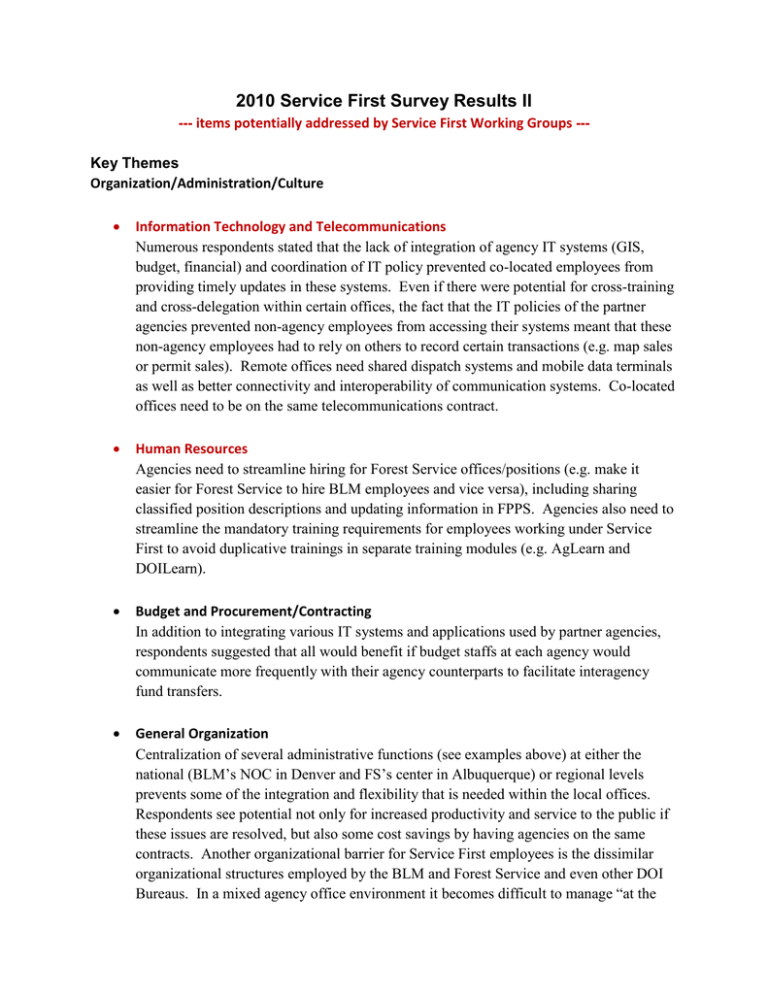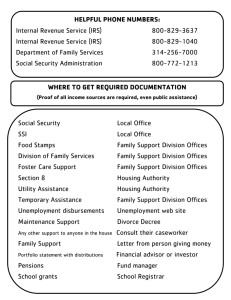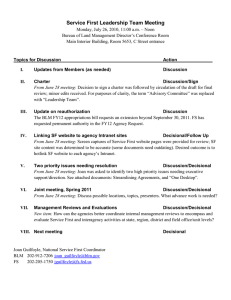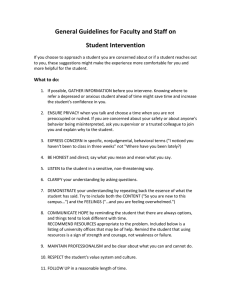2010 Service First Survey Results II
advertisement

2010 Service First Survey Results II --- items potentially addressed by Service First Working Groups --- Key Themes Organization/Administration/Culture • Information Technology and Telecommunications Numerous respondents stated that the lack of integration of agency IT systems (GIS, budget, financial) and coordination of IT policy prevented co-located employees from providing timely updates in these systems. Even if there were potential for cross-training and cross-delegation within certain offices, the fact that the IT policies of the partner agencies prevented non-agency employees from accessing their systems meant that these non-agency employees had to rely on others to record certain transactions (e.g. map sales or permit sales). Remote offices need shared dispatch systems and mobile data terminals as well as better connectivity and interoperability of communication systems. Co-located offices need to be on the same telecommunications contract. • Human Resources Agencies need to streamline hiring for Forest Service offices/positions (e.g. make it easier for Forest Service to hire BLM employees and vice versa), including sharing classified position descriptions and updating information in FPPS. Agencies also need to streamline the mandatory training requirements for employees working under Service First to avoid duplicative trainings in separate training modules (e.g. AgLearn and DOILearn). • Budget and Procurement/Contracting In addition to integrating various IT systems and applications used by partner agencies, respondents suggested that all would benefit if budget staffs at each agency would communicate more frequently with their agency counterparts to facilitate interagency fund transfers. • General Organization Centralization of several administrative functions (see examples above) at either the national (BLM’s NOC in Denver and FS’s center in Albuquerque) or regional levels prevents some of the integration and flexibility that is needed within the local offices. Respondents see potential not only for increased productivity and service to the public if these issues are resolved, but also some cost savings by having agencies on the same contracts. Another organizational barrier for Service First employees is the dissimilar organizational structures employed by the BLM and Forest Service and even other DOI Bureaus. In a mixed agency office environment it becomes difficult to manage “at the landscape level” when one partner has a three-tier structure and another has a four-tier structure and the boundaries for States and Regions do not match up (e.g. San Juan Public Lands Center in Colorado). This is also VERY complicated to explain to the public. Policy/Legal Framework/Culture • Even when some cross-training is available to employees, it is impossible for employees working in these Service First offices to learn all of the nuances of their partner agencies’ regulations and policies. Attempts to integrate these offices (through both policy and systems/tools) can be unpopular initially because it requires participants to learn new skills/practices or applications. • Though co-location is often cited as the most popular authority for partners to adopt because it is the most apparent sign of Service First, respondents indicated that it is not always possible to achieve because of either GSA space or leasing requirements or miscommunication between agencies about which one will be the lessee and which one will have to reimburse the other. • Agencies need to use one protocol or reporting system (for law enforcement) so that all can share one set of documents versus multiple sets routed through these separate protocols. • If all offices were cross-trained and cross-delegated they could protect all public lands, not just those within their own agency’s administrative responsibility. Respondents foresee this as a necessary change so that agencies can lead landscape level programs (climate change/adaptive management, biomass, water conservation youth and community engagement). • Some respondents suggested that cross-delegated employees be subject to a different dress code as appearing in their agency’s uniform reinforces both in the employees’ and the publics’ mind the separation of the agencies. • The Service First authorities have been in place for some time now and deserve to be encoded into the operational levels of participating agencies as well as additional agencies that were proposed to join the Service First family (BOR, BIA, etc.). This requires commitment, leadership, and enthusiasm from all likely participating agencies. It should not be considered a pilot program at this point. Service First needs to be distinguished from other partnership arrangements or interagency agreements that might have predated it and it needs to be tied to landscape-level performance goals/environmental goals. Agencies need to contribute to the periodic evaluation of its effectiveness and efficiency. Although the Service First Coordinator is never specifically mentioned, several respondents asked for both a communications and evaluation plan for Service First and access to a Service First website or collaborative workspace that could be more easily accessed and updated. • Agencies need a standardized process for developing and approving interagency Service First agreements (e.g. moving from paper-based system to electronic) and all aspects of the agreements need to be transparent. There needs to be a mutual understanding of the purpose, need, cost and responsibility of each party to the agreement. Several respondents were concerned that interagency cooperation could be stymied by this lack of transparency and agreement pertaining to “burden rates” or indirect costs that might be borne by one of the partner agencies. Conclusions and Possible Follow-up Actions/Recommendations It is clear that Service First has been around long enough to develop at least an internal constituency, but it also lacks sufficient brand recognition because is not considered permanent and apart from one or two Service First Coordinators there are few people charged with making it a success. Service First needs more high profile champions to continue its mostly positive legacy in land management. Recommendations • HR—Streamline mandatory training requirements for employees working under Service First to avoid duplicative trainings in separate training modules (e.g. AgLearn and DOILearn). • HR—Share classified position descriptions among Service First partner agencies to make it easier to staff Service First offices with appropriate personnel from each agency/Bureau. • Budget and Procurement/Contracting—Evaluate whether it’s feasible to place budget staff at the field office level to support Service First offices/employees and facilitate transfers or reimbursement of funds among Service First agencies. • Strategic Management —Manage Service First offices to lead landscape-level programs (e.g. climate change/adaptive management, biomass, water conservation, and youth and community engagement). • Leadership—Ensure that all land management agencies leaders champion Service First and through their leadership, commitment, and enthusiasm fully integrate and encode Service First into the operational levels of participating agencies. • Accountability—Develop an interagency evaluation plan and schedule for Service First that can measure the contributions and performance of all partners and publish the results of those evaluations. (It might be helpful to build this into a strategic plan for Service First). • • Accountability/Communication/Collaboration—Develop a communication plan for Service First that helps disseminate case studies, best practices, and lessons learned from the Service First experiences; including modifying the current Service First website to make it more collaborative/interactive. Transparency/Efficiency—Develop a standardized process for developing and approving interagency Service First agreements that all Service First agencies can use and stipulate that all aspects of the agreements need to be transparent (e.g. purpose, need, burden rates; roles & responsibilities). Other Potential Follow-up Actions (Longer-Term) There is existing case literature on Service First experiences around the country and this survey provides some additional examples; however these narratives may not be able to determine whether Service First has been successful or not. What are the stated objectives of Service First? Are there any performance measures in place for this or should the focus be on the environmental or other outcomes? How can we establish that causal link between the implementation of Service First authorities and other program successes? This would be an opportune time to develop a strategic plan for Service First (or modify one if it already exists) to include some systematic form of evaluation that involves not only the agencies, but the other beneficiaries—members of the public. Agencies would benefit from additional evaluations with more rigorous methodologies (combining qualitative and quantitative data analysis). Mapping out where Service First takes place could be very powerful (data visualization). The Service First Coordinator could use Social Network Analysis to determine the number of “players” in Service First and thereby confirm how widespread Service First was across the partner agencies and what the strengths of these relationships were. This could begin in the interagency meetings and could continue through e-mail and/or online. Agencies could also use GIS data to pinpoint and display on a map where Service First authorities were being used through symbols explained on a legend that represent each type of authority. This would also reveal potential new areas for Service First or Service First type activities in those gaps between states/regions or offices. Service First successes, once defined, need to be documented and publicized through a variety of channels to build continued support for these business practices. There should be more than just intrinsic benefits available to participants, but also an incentives system (public recognition in some form; partnership awards; promotions; training budgets to implement Service First; cost savings awards; ease of transitioning from BLM to NPS to FS for careers). Consider having booth at National Partnership for Public Service, Public Servant Recognition Week and other public events.



